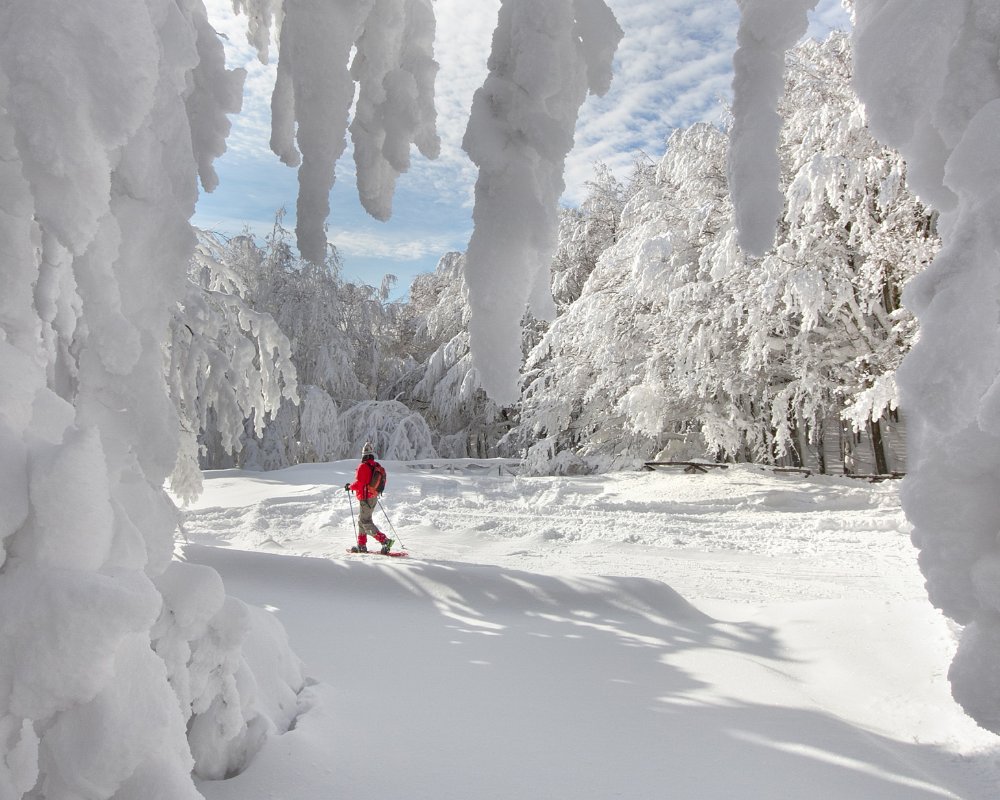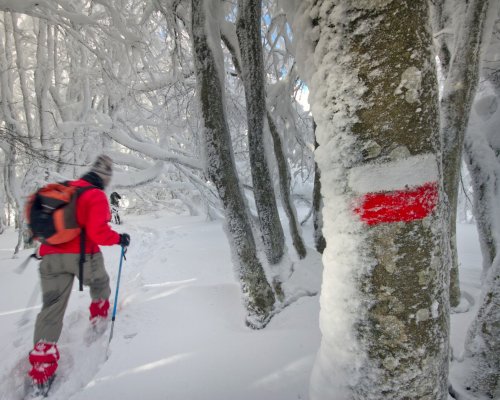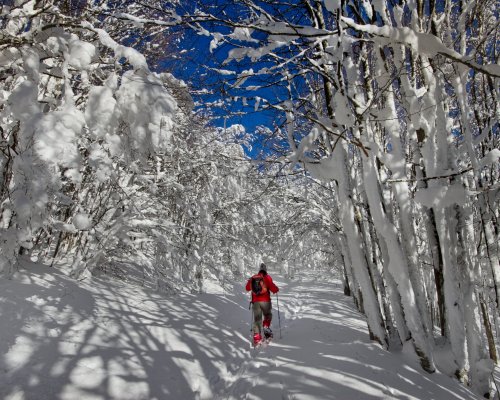In the shade of the Casentino’s thousand-year old forests
The National Park of Casentino Forests allows to experience pure contact with a wild, impenetrable forest. Explore the heart of the northern Apennine, in the presence of giants made of leaves and bark, that for centuries have guarded the nature of this place.
On the Florentine slope of the park you find a special place, a small village that barely emerges from the dense woods which inspire its name: Castagno d’Andrea, a village at the slope of mount Falterona and mount Acuto.
Immersed in the suggestive “Marronete”, chestnut woods farmed for the production of their precious fruits, Castagno d’Andrea was the birthplace of the renowned renaissance artist Andrea di Bartolo of Bargilla, called Andrea del Castagno, who became the true protagonist of Florentine painting in the 15th century.
Today the village is situated in the National Park of Casentino Forests, Mount Falterona and Campigna, and hosts one of the nine Nature Routes of the park, a series of itineraries suitable to anyone’s capability, which enclose along the pathway the natural peculiarities of the Tuscan-Emilian Apennine. On the municipal ground is located the visitors centre of the National Park, in the heart of a land that for centuries saw its own local economy revolve around wood and the Mugello chestnuts, a real a proper treasure of these valleys, and irreplaceable products for the local cuisine. A journey through the traditional gastronomy isn’t limited however by chestnuts: products range from meats – such as Ciavar, the ‘matta’ sausage, and Gota, a cured meat taken from pork cheek – cheeses, followed by honey, the delicious Fir Tree Honeydew, and the Londa queen peach.
We depart from the park’s Visitors Centre and proceed along the Castagno country road, a winding track that enters the wood. You ascend with the car until reaching the car park and the barrier that indicates the beginning of the trail in the locality of Fonte del Borbotto. We enter through the trees following the path. On the right, a path splits heading to a dense beech wood and immediately reaches a spring.
We follow the signs for the Valico delle Crocicchie indicated by the route CAI n.17. In a few minutes we will arrive at Gorga Nera, a small marsh that conceals mysterious legends. They narrate that within the pool is enclosed a cave that led to the mouth of the River Arno, the source of the Tuscan river and a dark place where Dante Alighieri appears to have been inspired when conceiving his “Dark Forest”. A second legend concerns the Basilisk, a creature similar to a snake with the wings and head of a bird, that paralysed animals and people with its eyes and that, according to beliefs, found refuge in the pond’s vicinity. Also documented is the presence of common frogs, characterised by dark marks behind their eyes, which live in Gorga Nera with one of the largest populations of the park.
We depart from the park’s Visitors Centre and proceed along the Castagno country road, a winding track that enters the wood. You ascend with the car until reaching the car park and the barrier that indicates the beginning of the trail in the locality of Fonte del Borbotto. We enter through the trees following the path. On the right, a path splits heading to a dense beech wood and immediately reaches a spring.
We follow the signs for the Valico delle Crocicchie indicated by the route CAI n.17. In a few minutes we will arrive at Gorga Nera, a small marsh that conceals mysterious legends. They narrate that within the pool is enclosed a cave that led to the mouth of the River Arno, the source of the Tuscan river and a dark place where Dante Alighieri appears to have been inspired when conceiving his “Dark Forest”. A second legend concerns the Basilisk, a creature similar to a snake with the wings and head of a bird, that paralysed animals and people with its eyes and that, according to beliefs, found refuge in the pond’s vicinity. Also documented is the presence of common frogs, characterised by dark marks behind their eyes, which live in Gorga Nera with one of the largest populations of the park.
From the pool of Gorga Nera we press on into the forest. The route immediately becomes steeper as you reach the evocative meadowland in the crossing of the Crocicchie. We cross the CAI 00 route, while continuing to descend on 17 and successively on a dirt track until Capo d’Arno, at 1.372 m above sea level.
This point, which is indicated by a stone plaque, is the site where the most important Tuscan river flows, the Arno, that “A small stream winds through Tuscany, which up in Falterona hath its rise, and is not sated by a hundred miles”, as described by Dante in his Purgatory.
Once restarting, we continue onwards to the lake of Idols¸ a small water pool which in its vicinity were discovered various statues of Etruscan, Greek-Hellenistic and Roman origin. Throughout the 19th century, the site became a proper excavation site, which caused the lake to dry up. Restored not long ago, it is inserted in a splendid forest. Some of the statues that were found are now conserved in the Archaeological Museum of the Casentino in Bibbiena.
From the pool of Gorga Nera we press on into the forest. The route immediately becomes steeper as you reach the evocative meadowland in the crossing of the Crocicchie. We cross the CAI 00 route, while continuing to descend on 17 and successively on a dirt track until Capo d’Arno, at 1.372 m above sea level.
This point, which is indicated by a stone plaque, is the site where the most important Tuscan river flows, the Arno, that “A small stream winds through Tuscany, which up in Falterona hath its rise, and is not sated by a hundred miles”, as described by Dante in his Purgatory.
Once restarting, we continue onwards to the lake of Idols¸ a small water pool which in its vicinity were discovered various statues of Etruscan, Greek-Hellenistic and Roman origin. Throughout the 19th century, the site became a proper excavation site, which caused the lake to dry up. Restored not long ago, it is inserted in a splendid forest. Some of the statues that were found are now conserved in the Archaeological Museum of the Casentino in Bibbiena.
We continue through the beech wood until the field of Montelleri. From here the route deviates to the left and begins its ascent towards the summit of Falterona. To directly reach the peak, which is indicated by a wooden cross, you follow route number 3. It is worth however slightly extending the itinerary, by taking the trail on the right that, in about half an hour, takes you to mount Falco, the roof of the Casentino, at 1.658 m above sea level.
The path takes us onto a ridge in a mild ascent until the grassy summit of the Falco. Its summit is a splendid balcony overlooking both the Tuscan and the Emilian slopes, representing the Apennine divide.
To conclude the circular route, we follow the ridge that leads to the summit of Falterona and take route no. 16 GEA on the right that descends into a dense pine forest. Still in descent, the ridge becomes steeper and rockier, after which it returns into a beech wood that takes us to the locality of La Stufa in the valley. Turning left, after a couple of minutes we reach the starting point of Fonte del Borbotto.
We continue through the beech wood until the field of Montelleri. From here the route deviates to the left and begins its ascent towards the summit of Falterona. To directly reach the peak, which is indicated by a wooden cross, you follow route number 3. It is worth however slightly extending the itinerary, by taking the trail on the right that, in about half an hour, takes you to mount Falco, the roof of the Casentino, at 1.658 m above sea level.
The path takes us onto a ridge in a mild ascent until the grassy summit of the Falco. Its summit is a splendid balcony overlooking both the Tuscan and the Emilian slopes, representing the Apennine divide.
To conclude the circular route, we follow the ridge that leads to the summit of Falterona and take route no. 16 GEA on the right that descends into a dense pine forest. Still in descent, the ridge becomes steeper and rockier, after which it returns into a beech wood that takes us to the locality of La Stufa in the valley. Turning left, after a couple of minutes we reach the starting point of Fonte del Borbotto.


